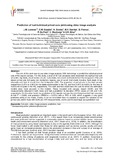Mostrar el registro sencillo del ítem
Prediction of foal individual primal cuts yield using video image analysis
| dc.creator | Lorenzo, José M. | es_ES |
| dc.creator | Guedes, C. M. | es_ES |
| dc.creator | Zdolec, N. | es_ES |
| dc.creator | Sarriés Martínez, María Victoria | es_ES |
| dc.creator | Franco, D. | es_ES |
| dc.creator | Palo, Pascuale de | es_ES |
| dc.creator | Muchenje, V. | es_ES |
| dc.creator | Silva, S. R. | es_ES |
| dc.date.accessioned | 2019-09-10T10:46:29Z | |
| dc.date.available | 2019-09-10T10:46:29Z | |
| dc.date.issued | 2018 | |
| dc.identifier.issn | 0375-1589 | |
| dc.identifier.uri | https://hdl.handle.net/2454/34786 | |
| dc.description.abstract | The aim of this work was to use video image analysis (VIA) technology to predict the individual primal cuts of the equine carcass. For this study, a total of 42 foal carcasses were dissected into eight primal cuts (shoulder, top blade, chuck tender, chuck, neck, blade, fore shank and brisket) from the forequarter (FQ) and eleven primal cuts (full plate, loin, tenderloin, topside, eye of round, hind shank, knuckle, flank steak, tri-tip, silverside and heel of round) from the hindquarter (HQ). The proportion of primal cuts in the total carcass ranged from 0.27% to 4.84% for the blade and shoulder in the FQ, and from 0.97% to 8.60% for the heel of round and full plate in the HQ, respectively. The neck and fore shank were the cuts for which the estimation models were most accurate in the models. These included cold carcass weight (CCW) and VIA measurements obtained in both views and had a prediction to deviation (RPD) values of 1.85 and 1.90, respectively. On the other hand, the prediction of the topside cut was the one that presented high accuracy (k-fold-R2 = 0.829) and precision (RMSEcv = 0.23%) with a RPD of 2.85, which suggests a very good predictive ability of the model. Finally, it can be concluded that it is possible to explain the variation of the primal cuts yield in foals with CCW and VIA measurements, and to use this technique as a prediction tool. © 2012 South African Society for Animal Science. | en |
| dc.description.sponsorship | This work was supported by RTA2012-00090-C03-01 (INIA). José M. Lorenzo is member of the MARCARNE network, funded by CYTED (ref. 116RT0503). | en |
| dc.format.extent | 9 p. | |
| dc.format.mimetype | application/pdf | en |
| dc.language.iso | eng | en |
| dc.publisher | South African Bureau for Scientific Publications | en |
| dc.relation.ispartof | South African Journal of Animal Sciences, Vol. 48, No. 6 (2018), pp. 1057-1065 | en |
| dc.rights | © resides with the authors in terms of the Creative Commons Attribution 4.0 South African License. | en |
| dc.rights.uri | https://creativecommons.org/licenses/by/4.0/za/ | |
| dc.subject | Cut yield | en |
| dc.subject | Foal | en |
| dc.subject | Prediction | en |
| dc.subject | Video image analysis | en |
| dc.title | Prediction of foal individual primal cuts yield using video image analysis | en |
| dc.type | info:eu-repo/semantics/article | en |
| dc.type | Artículo / Artikulua | es |
| dc.contributor.department | Agronomía, Biotecnología y Alimentación | es_ES |
| dc.contributor.department | Agronomia, Bioteknologia eta Elikadura | eu |
| dc.rights.accessRights | info:eu-repo/semantics/openAccess | en |
| dc.rights.accessRights | Acceso abierto / Sarbide irekia | es |
| dc.identifier.doi | 10.4314/sajas.v48i6.8 | |
| dc.relation.projectID | info:eu-repo/grantAgreement/MINECO//RTA2012-00090-C03-01/ES/ | en |
| dc.relation.publisherversion | https://doi.org/10.4314/sajas.v48i6.8 | |
| dc.type.version | info:eu-repo/semantics/publishedVersion | en |
| dc.type.version | Versión publicada / Argitaratu den bertsioa | es |



